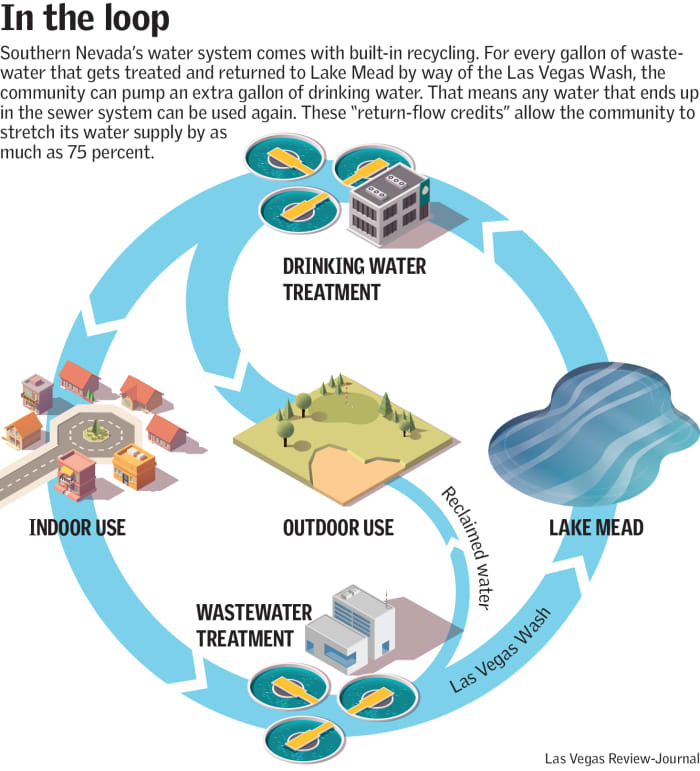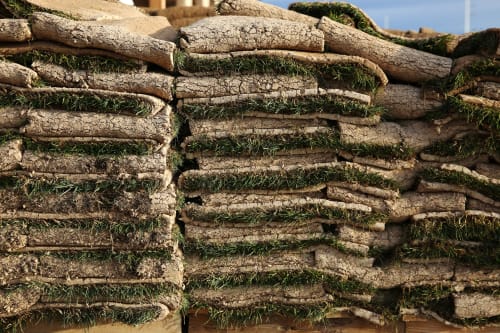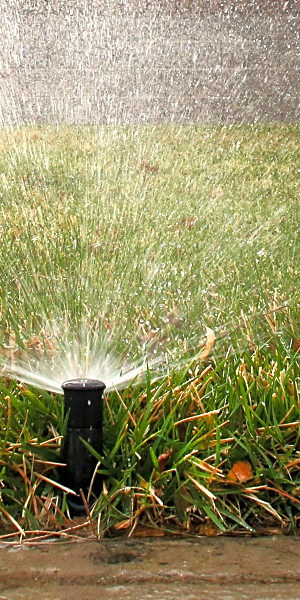aving water in Las Vegas is an all-out turf war, and the campaign is far from over. Since 1999, the Southern Nevada Water Authority has overseen the removal of more than 187 million square feet of grass and prevented untold millions more from being planted through a 2004 ban on lawns in front of new homes and commercial properties. Limiting turf has allowed the community to add roughly 650,000 new residents over the past decade and a half while cutting overall water use by 26 percent.
“Probably the most meaningful thing that we’ve ever done in this valley is to regulate the use of ornamental turf grass,” said water authority conservation manager Doug Bennett.
And there’s still plenty of green out there to eliminate.
Authority General Manager John Entsminger said the effort so far has only eliminated about half of the “nonfunctional turf” that can be realistically removed from the valley. “So in theory, if you could take out the same amount of turf over the next 20 years, not only could you add another 650,000 people, you could actually be using less water than you’re using today,” he said.
Stretching the water supply as far as possible is expected to take on added significance next year, when the authority could be forced to cut its annual Colorado River entitlement to help slow Lake Mead’s decline. Even before that, the seven Western states that draw water from the river face a March 19 federal deadline to submit plans to voluntarily trim their use on top of mandatory cuts likely to kick in Jan. 1.
“The more turf we can remove from the valley, the more secure our water portfolio becomes for everyone who lives here (now) and everyone who lives here in the future,” Entsminger said. “I don’t care about soccer fields and schools. I want the grass that only gets walked on when it’s being mowed out of the valley. If we do that, we’re not going to have a water supply problem in this community for the foreseeable future.”
Not-so-green valley
Already, the authority’s turf rebate program is credited with saving about 10 billion gallons of water a year — enough to supply more than 65,000 average households. Since its inception 20 years ago, the program has paid residents and business owners more than $220 million to replace their grass with desert landscaping.
After more than 50 years in Las Vegas, Mary Klosowski-Lewis finally gave up the lawn in front of her northwest valley home late last year.
“It just gets a little expensive with this big a yard and watering the grass,” she said. “It just seemed like it was the time to do it.”
The higher rebate amount adopted by the authority in December also helped.
“The incentive’s very nice. It’s $3 a square foot, and it’s a lot of foots,” Klosowski-Lewis said with a laugh.
Residents aren’t the only ones ripping out their turf.
The city of Las Vegas has saved an estimated 300 million gallons of water and $1.3 million in water costs over the past decade by removing 1.2 million square-feet of turf from parks and golf courses, rolling out 28 artificial turf ballfields and decorating street medians with rocks and metal sculptures instead of plants.
In Henderson, most of the golf courses and a few of the landscaped roadway medians are irrigated with reclaimed wastewater, while parks in Nevada’s second-largest city are getting less grassy by the minute.
Parks Superintendent Doug Guild said Henderson has eliminated a substantial amount of turf from older parks and changed the way new ones are designed to minimize thirsty grass.
“In the past, we used to put grass everywhere,” he said. Now a park might get one small patch to play on. The average amount of turf coverage has gone from as much as 90 percent at the city’s oldest parks to around 10 percent at its newest ones.
Over the last 15 years, he said, Henderson has removed 1.5 million square feet of turf and saved about 82 million gallons of water — enough to fill 115 Olympic-size swimming pools.
To improve efficiency, the city has installed high-tech irrigation systems that measure soil moisture and track the weather so the turf only gets as much water as it needs.
This summer, Guild said, Henderson will begin converting the ballfields at eight parks from fescue to a more durable Bermuda grass that turns brown but only needs to be watered once a month or so in winter.

The city has also experimented with synthetic turf at its Heritage Sports Complex, but Guild said sports teams seem to prefer to play on the real stuff.
Many miles left to go
Valleywide, Bennett said, the amount of turf replaced so far is enough to form an 18-inch-wide roll of sod more than 24,000 miles long. If you unspooled that roll along the equator, it would stretch roughly 95 percent of the way around the globe, he said. “And I’m not retiring until we close the gap, I can tell you that.”
When the authority hired him in 2000, Bennett never imagined there was so much grass growing in the Las Vegas Valley. Now thanks to multispectral aerial imagery, computer modeling and the anecdotal observations he’s made driving around town, he knows there’s “maybe another 25,000-mile roll of sod that’s sitting in people’s front yards and on street corners and other places where it’s not serving a functional use.”
Bennett and his colleagues hope to eliminate that gradually through the turf rebate program and keep it out with stricter landscaping codes, enforcement and community outreach.
But water officials insist they are not waging a scorched-earth campaign. Turf used for playgrounds, ballfields, parks and even golf courses is fine with them.
“It’s the nonfunctional turf, the ornamental turf that we’re really after,” Entsminger said. “I live in Summerlin, and I’m angry every day when I drive by traffic circles with spray irrigation in them. I always imagine the poor landscaper who has to get the lawn mower out there at 4 in the morning through a traffic circle.
“Or, worse, Summerlin Parkway,” he added. “I mean, we have grass in the middle of highways.”
Some of the valley’s wealthiest residents haven’t gotten the message yet, either.
There is a saying that water flows uphill toward money. In Southern Nevada, a disproportionate share ends up inside the walls of guarded, gated communities with lush lawns and names like Spanish Trail, The Fountains, Canyon Gate and Anthem Country Club. Some of these opulent neighborhoods are home to the valley’s largest residential users — single addresses that gulp down enough water each year to supply 50 to 80 average valley homes.
“Every now and then I get an invitation to go visit someone I know in some exclusive gated community, and in some of them I drive into, it looks like it’s 1994 all over again,” Bennett said. “We just need to make better decisions about what our landscapes and outdoor living spaces are and what functions they provide to us.”
Contact Henry Brean at hbrean@reviewjournal.com or 702-383-0350. Follow @RefriedBrean on Twitter.

Pallets of sod are displayed at Star Nursery in March in Henderson. (Bizuayehu Tesfaye/Las Vegas Review-Journal)
Turf-rebate timeline
1999: The program, then known as Southern Nevada Xeriscapes, is launched with a water bill credit of 25 cents for every square-foot of lawn replaced with desert landscaping.
2000: The credit is raised to 40 cents per square-foot.
2002: The initiative is rebranded as the Water Smart Landscapes program.
2004: In response to worsening drought on Colorado River, the bill credit becomes a cash rebate and jumps to $1 per square-foot. The result: almost 9,000 turf conversions totaling more than 34 million square-feet, the biggest year by far in program history.
2007: To boost waning participation, the Southern Nevada Water Authority increases the rebate to $2 for a year, then sets it at $1.50 per square-foot.
2015: The rebate returns to $2.
December 2018: The authority ups the payout to $3 per square-foot and eases size limitations to attract more large conversion projects.



